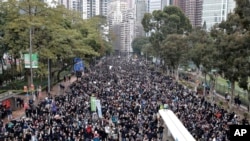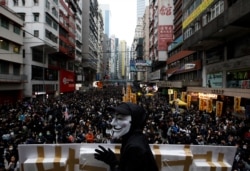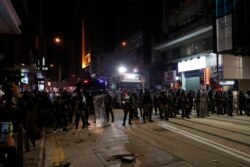Hong Kong’s celebratory mood on the first day of 2020 was marred by tear gas and water cannons deployed by police on a largely peaceful crowd, and the arrest of some 400 people at a march attended by hundreds of thousands in what has been a months-long anti-government movement.
Senior Superintendent Ng Lok Chun told reporters late Wednesday that police arrested about 400 people during the New Year's Day march on charges including illegal assembly and the possession of offensive weapons. He said police fired tear gas after being surrounded by protesters who were throwing objects at them. He blamed radical protesters for "hijacking" and disrupting the march.
The Asian financial hub has been roiled by civil unrest for seven months, and protesters say they will not back down in their demands for universal suffrage and an independent probe into police brutality against the movement that saw nearly 6,500 people arrested. The anti-government movement was sparked by a controversial extradition law that allowed individuals to be sent to China for trial.
Hong Kong’s New Year’s Eve fireworks display had been canceled for the first time in its 10-year history by officials who cited public safety concerns. But revelers converged nonetheless on the streets of Hong Kong on Tuesday night. Shortly after midnight, as joyful shouts of “Happy New Year!” rang across the city, police in the bustling downtown district of Mongkok fired tear gas at a crowd that set off fireworks and burned roadblocks.
Just before that, police deployed a water cannon vehicle in the area to disperse protesters, while armored vehicles cleared roadblocks set up earlier by protesters. People had gathered outside a metro station earlier to commemorate rumored deaths in a clash between protesters and police on August 31. The government repeatedly has denied that anyone died.
Hundreds of thousands from all walks of life turned up at an organized demonstration pre-approved by police on Wednesday afternoon. The mood at the march, attended by individuals, families with children and the elderly, was peaceful and relaxed at the outset. Many chanted slogans, including "Liberate Hong Kong, revolution of our era!"
The atmosphere turned tense shortly after 5 p.m. local time, though, when police arrested several people for allegedly vandalizing an HSBC bank in Wanchai district, and angry protesters threw objects and began shouting. Riot police then fired rounds of tear gas and some protesters retaliated by throwing firebombs at them.
Many in the crowd were peaceful protesters who had not worn protective gear and felt unwell after inhaling the noxious gas. A police statement issued later said some had damaged facilities, and glass doors and an ATM at the bank.
The organizer of the march, Civil Human Rights Front, called off the demonstration at the request of police, but many protesters continued. Police threatened them with warnings, accusing them of taking part in an illegal assembly. The group later said an estimated 1 million people had taken part in the march.
Later at night, police used water cannons on crowds in Wanchai and the financial hub of Central. Protesters had laid bricks across the main road in Central in an attempt to block police from entering the area. A police statement said protesters blocked roads with barricades, dug up bricks from pavement and set fire to banks and ATMs.
The Civil Human Rights Front condemned police for using “absurd excuses” to terminate the march and accused them of failing to listen to the people’s voices and infringing upon their right of assembly.
“Hong Kongers shall not back down and peace shall not resume with the ongoing police brutality,” Civil Human Rights Front said in a statement.
Although many Hong Kongers say they remain determined in their fight for democracy under Chinese rule, some are voicing doubts about the effectiveness of the violent confrontations. Others are calling on fellow Hong Kongers to put pressure on the government by boycotting pro-Beijing businesses and joining labor unions for more effective collective actions, such as strikes.
“I don’t want to back down, I feel antagonized by the authorities but I am also hoping for a new direction in the movement,” said an office administrator who joined the march. “I hope people can also use other means to put pressure on the government.”
















